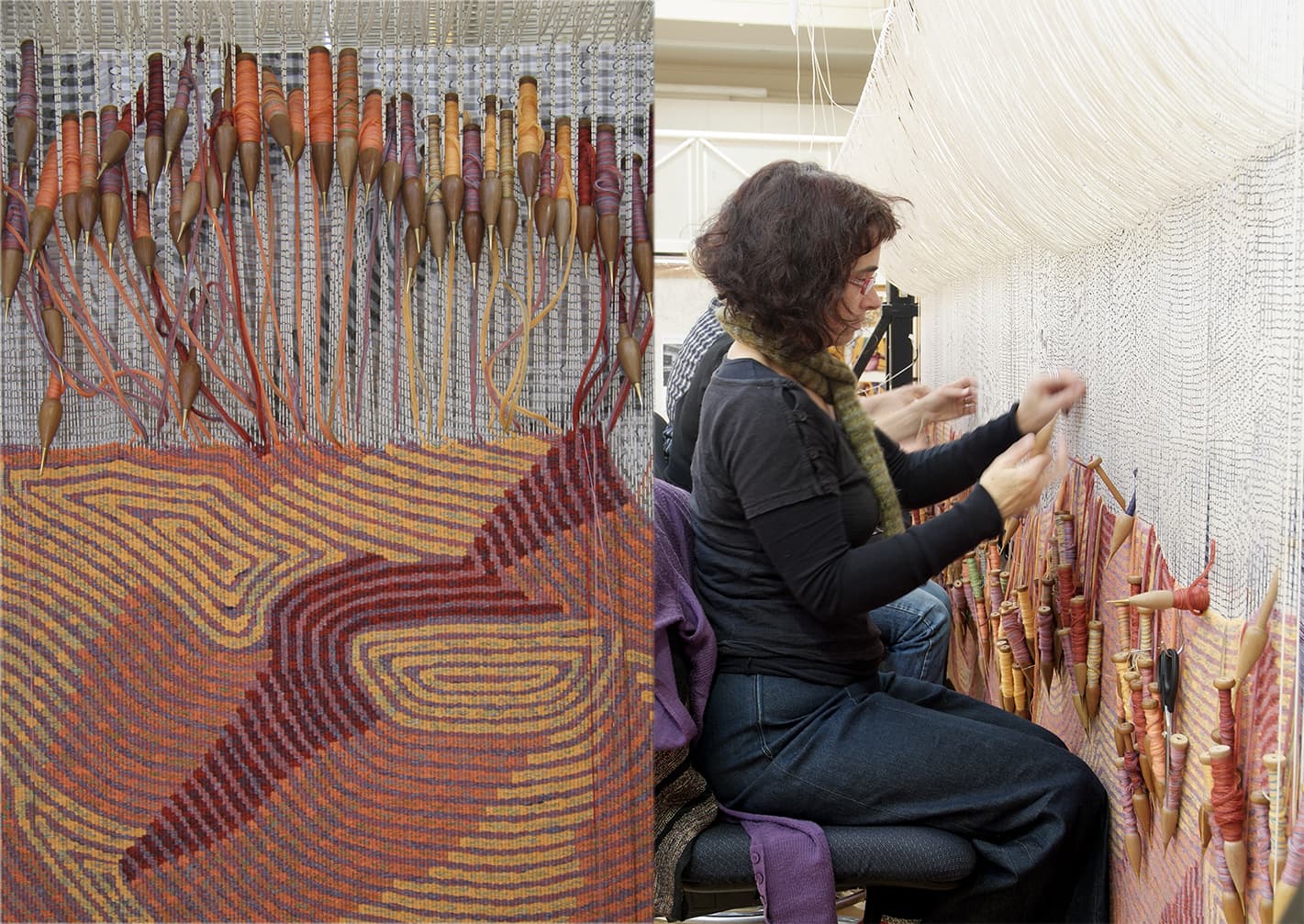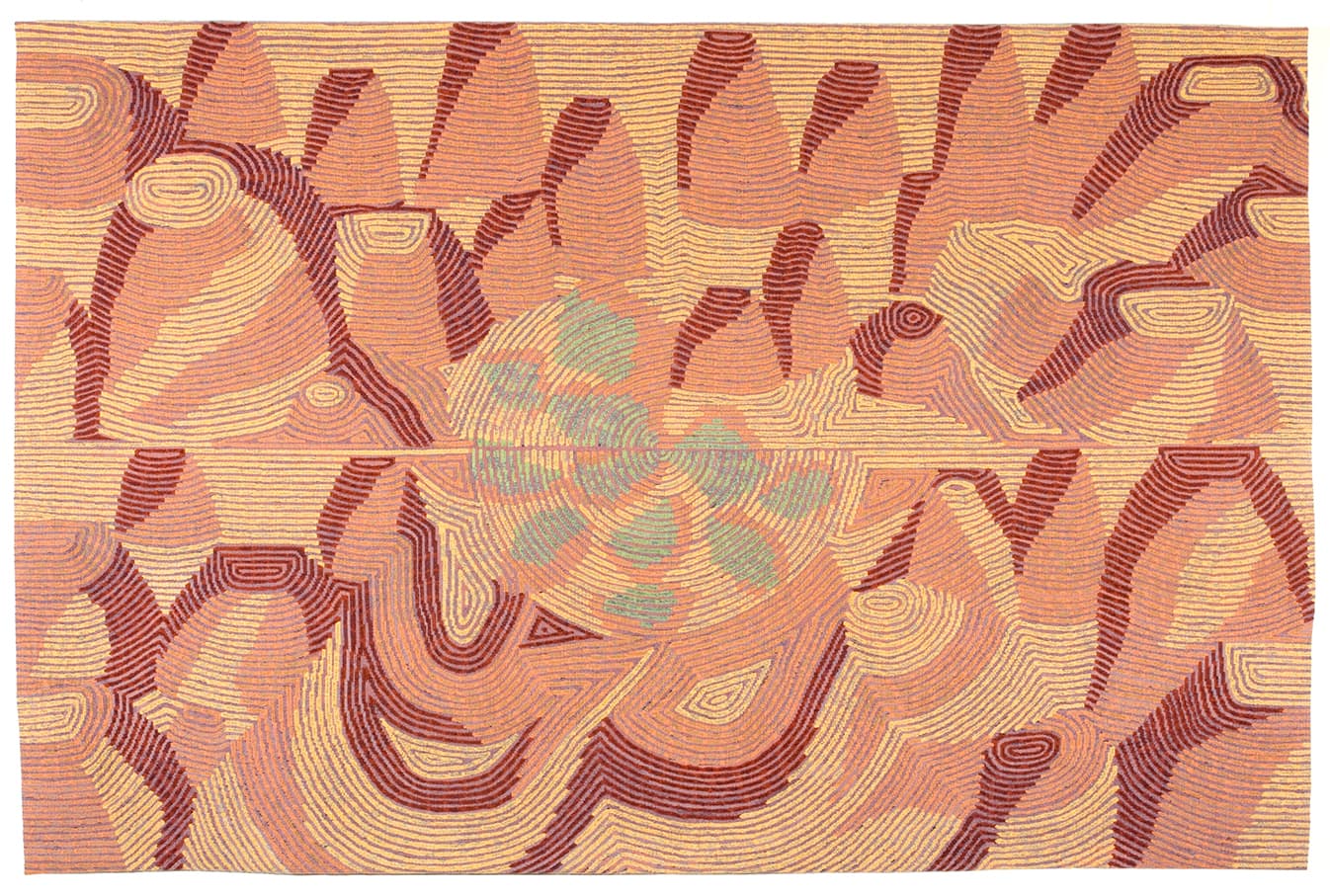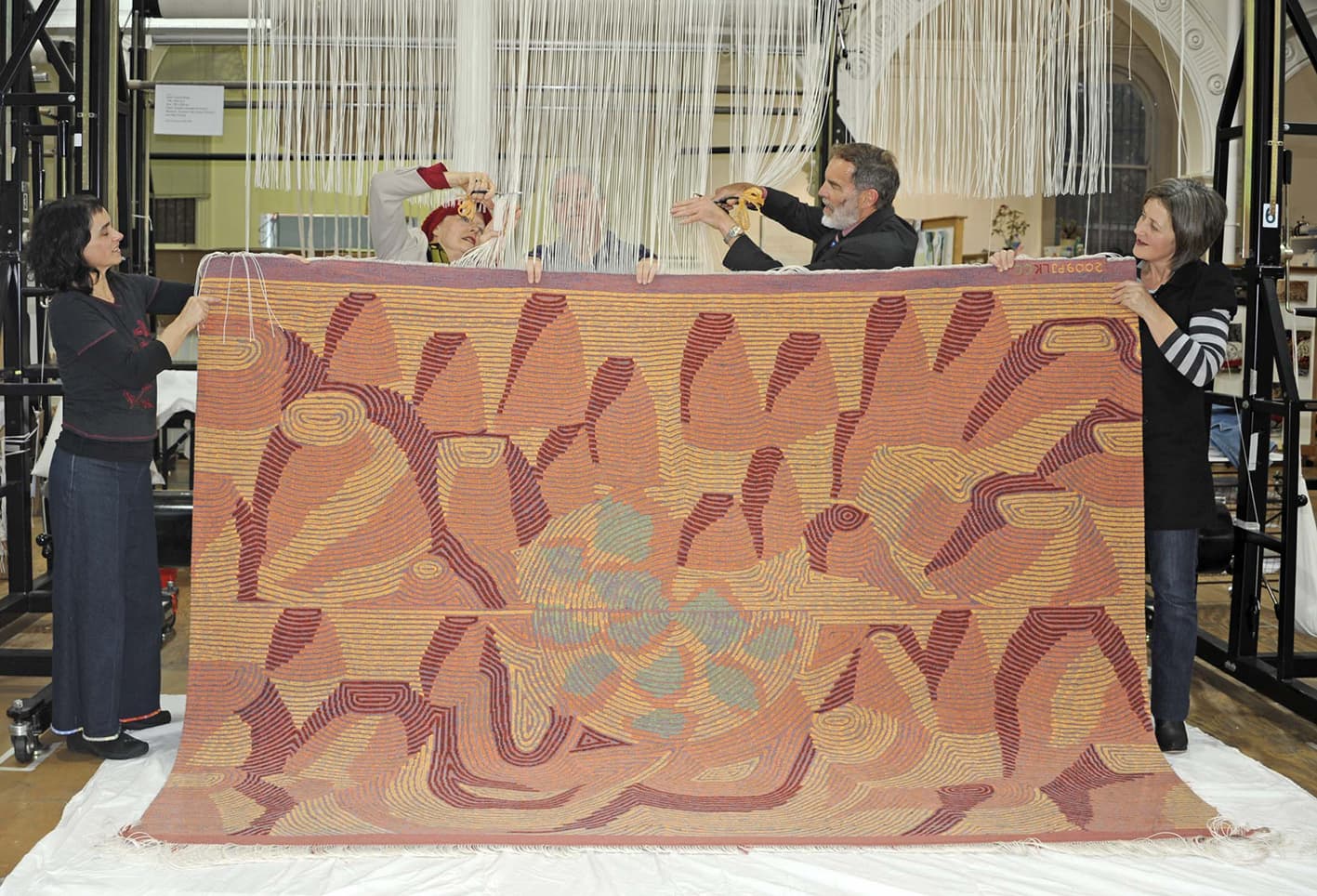



Having been raised within the Pupunya Tula art movement, it wasn’t until 1998 that Elizabeth Marks Nakamarra began painting in her own right. Nakamarra’s painting Creek bed was translated into tapestry by ATW weavers in 2009, as the fifth addition to the ATW’s Embassy Collection.
Growing up Nakamarra assisted her stepfather Turkey Tolson Tjupurrula and uncle Johnny Warangkula Tjupurrula, with their paintings, and continued to assist her late husband Mick Namarari Tjapaltjarri with his painting until his death in 1998. Nakamarra studied for three years at the Bachelor College in Alice Springs and served as a council member in Kintore for two years. After the death of her husband, Nakamarra began painting her father’s stories from the area of Kalipinypa, located approximately 400 km west of Alice Springs and north of Sandy Blight Junction.
Nakamarra’s paintings revolve around the subject of the Dream Time—the time before man walked the earth, when a huge storm caused lightning to flash and the water torrent formed the landscape creating rock holes, soaks and creeks. Her paintings depict this wellspring of life; the water sources, throughout the diverse terrain of the western desert, both heavenly and subterranean.
The ATW Embassy Collection consists of tapestries designed by Indigenous Australian artists, produced specifically to be loaned to Australian Embassies around the world. Creek bed is currently on loan to the Australian Embassy in Paris, designed by Harry Seidler and opened in 1978.
The original painting has a subdued understated palette that belies the complex painterly nature of the work. The weavers had to make many complex decisions regarding the amount of painterly information to include in the interpretation and the most economical ways to recreate Nakamarra’s limited but layered and complex colour scheme. When interpreting the artwork, the weavers found that the linear brush strokes required much thought, as they simultaneously describe the forms within the painting while also sitting forward or back to generate a sense of space and movement within the work. Each line is made up of distinct brush strokes, approximately 2 cm long, which have distinct borders around the edges and a slight translucency in the centre. Elizabeth’s lines have been painted onto a black background.
The weavers have simplified Nakamarra’s brush strokes in their interpretation, and have limited their palette to 3 or 4 tones in each bobbin for the four main colours in the tapestry- a close equal to the ‘real’ colour, a brighter tone and a colour to represent the background, with another tone or colour as needed. A blue instead of a black has been chosen to express the background and will run through all the bobbins as well as being used as a pure colour that will peep through the edges of some of the forms, acting as highlights—a detail the weavers have included from the painting. The weavers chose this colour as it blends more harmoniously with the other tones in their interpretation and works well when included in the schema of the four main colour mixes.
Creek bed was commissioned by the Tapestry Foundation of Australia, and funded by private donations.
In 2008 Jon Cattapan designed The Visitor, commissioned specifically for The Performing Arts Centre at Xavier College in Melbourne.
Cattapan has spent the last 30 years depicting the urban environment and exploring ways of conveying a sense of identity and place. The tapestry design presents an aerial view of a nocturnal light-streaked cityscape, with a cluster of figures in the foreground. The city lights can also be read as computer pixels or datasets.
When discussing the design, Cattapan noted:
“The Visitor shows a group of youths in a vast panoramic landscape that appears to have elements of many cities within it. It is a dissolving, fluid vista that speaks of an age of digital global information - of floating bytes of data. In the foreground is an arrival. For the visitor, the potential journey is one of hope and belonging, whilst for the group, what is represented is not only a newcomer but symbolically the challenge of new ideas."
Xavier College used the creation of The Visitor as an opportunity to involve students on a curriculum level. The artist gave a series of lectures at the school and students undertook projects at the Workshop, such as filming an interview with the artist and recording the various stages of the tapestry production.
Jon Cattapan has exhibited widely in museum and commercial shows throughout Australia and overseas.
In 2005 the ATW completed work on Forest Noise, designed by Ian Woo, in preparation for an exhibition to be held at Singapore Tyler Print Institute entitled The Art of Collaboration: Masterpieces of Modern Tapestry.
Singapore-based Woo’s abstract paintings are characterized by both their visual complexity, and also paradoxically by their simple thoughtfulness. Woo frequently alludes to the everyday, visually depicting gestures, transient moments and thoughts.
Speaking of the design, Woo noted that it “is a kaleidoscopic work informed by fractured compositions of paint and text activities that simulate disturbances in the midst of the painting’s horizontal suspensions.”
The design for Forest Noise incorporates fractured sections of text juxtaposed against more organic imagery. It seems that it is the ‘clash’ or opposition of forms that conveys Woo’s investigation of the “memory and essence of the forest… and the city,or the differing sounds, memories and sensations of urban and natural space.”
To honour and celebrate Danish architect, Jørn Utzon’s design of the Sydney Opera House, the ATW translated Homage to Carl Philip Emmanuel Bach into a monumental tapestry, spanning 2.67 x 14.02m, in 2003.
Utzon (1918–2008) was the designer of Australia’s most distinctive national icon, the Sydney Opera House (SOH). He won the tender for the Opera House in 1957, but the project was besieged by political wrangling, budget overhauls and compromises to his design resulting in Utzon’s resignation before the building’s completion in 1973. Later acknowledged as the creator of an architectural masterpiece, he was awarded a Hononary Doctorate from the University of Sydney in 2003 and in the same year received a Companion of the Order of Australia, as well as architecture’s most prestigious international award, the Pritzker Prize.
As the interior of Utzon’s original design had never been fully realised, he was recommissioned in 2000 to oversee a redevelopment of the building’s interior. The first space to be redesigned to Utzon’s specifications was the Reception Hall, re-named The Utzon Room, in his honour. The venue features the tapestry Homage to Carl Philip Emmanuel Bach, inspired by CPE Bach’s Hamburg Symphonies and Raphael’s painting Procession to Calvary. The tapestry derives from a collage featuring torn strips of coloured paper writ large into floating forms that take on an architectural dimension. Against the pale-blonde timber floor and walls, the tapestry glows with vibrancy and movement. The shapes tumble across the length of the work in an almost musical configuration: like a notation of syncopated acoustic elements forming point and counterpoint over the picture plane.
Due to the large scale of the tapestry, the weavers wove the design on it’s side.
The SOH was declared a World Heritage Site on 28 June 2007. Utzon became only the second person to have received such recognition for one of his designs during his lifetime.
To celebrate the Melbourne Cricket Ground’s 150th anniversary, the Melbourne Cricket Club tapestry, designed by Robert Ingpen AM was woven by the ATW in 2002.
The monumental tapestry, measuring 2.00 x 7.00m, depicts key members of the Melbourne Cricket Club (MCC). Placed in chronological order, the figures depicted range from the MCC’s first president, Frederick Powlett, to champion Australian batsman-keeper Adam Gilchrist and Socceroo Kevin Muscat, who kicked Australia’s only goal in its 1-0 victory over Uruguay in a 2001 World Cup qualifying match.
Included are some of the greats of football and cricket, memorable sporting events such as the 1956 Olympic Games and Austral Wheel Races and other notable occasions like royal and papal tours, Billy Graham’s Crusade and the performance by the Three Tenors.
Ingpen painted the figures individually and then painted a broader yellow / orange canvas, allowing the weavers to position the figures as the tapestry developed on the loom.
The tapestry hangs proudly outside the Long Room at the MCG, where members and visitors can admire and identify those who have made a significant contribution to what the MCG is today.
Robert Ingpen is represented by Melaleuca Gallery in Victoria.
Taking six ATW weavers almost 2 years to complete, the Aotea Tapestry, designed by Robert Ellis is a significant contemporary tapestry and one of the principle artworks in the Aotea Centre’s collection.
Ellis is a prominent British-born New Zealand painter who is concerned with social, cultural and environmental themes.
Speaking of the tapestry, Ellis noted: “It was not my intention to be too specific, as many people will prefer to interpret it in their own way. There are many different levels of meaning, depending on the viewer’s outlook.”
Robert Ellis’ work is held in many major institutions. He is represented by Milford Galleries in Dunedin.